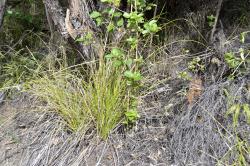- Taxon
- Weed
- Gallery
- = Carex longifolia R.Br. nom. illeg.
Robust, harsh, dense tussocks 30–90 cm high; tillers intravaginal. Stems ± terete, slender, smooth, drooping. Leaves 3–5 mm wide, ± = stems, harshly scabrid, strongly keeled, Y-shaped in cross-section, bluish-green, almost white at base above the red-brown sheath. Inflorescence a drooping panicle with long-peduncled spikes in fascicles of 3–4 from each node; bracts leaf-like, conspicuous but < inflorescence. Male spike 1, 4–5 cm × c. 1.5 mm, invariably with a few female flowers interspersed, shortly pedunculate; glumes ± oblong, acute to mucronate. Female spikes 1.5–6 cm × 3–4 mm, on filiform drooping peduncles much > spikes, flowers up to 30 in longest spikes, lax; glumes < utricles, 3.5–4.5 mm long, ovate, light brown, keel scabrid, mucro short. Utricles c. 6 × 1.5 mm, distinctly nerved, margins strongly scabrid, trigonous, fusiform beak to 2 mm long, bifid, stipe long, ± 1.5 mm. Stigmas 3. Nut trigonous, obovoid.
[From: Healy and Edgar (1980) Flora of New Zealand. Volume 3.]




